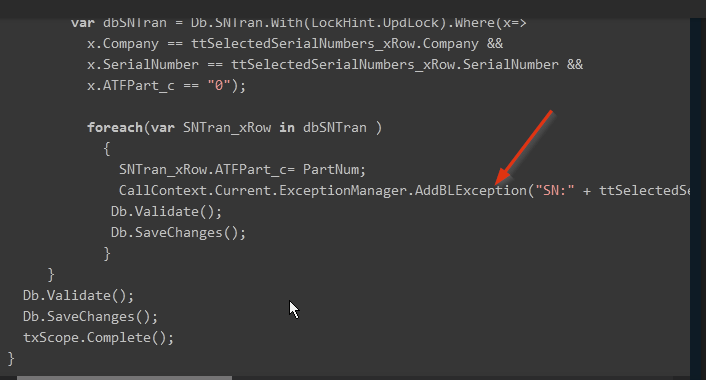I have tried this code in a Method Directive in Quantity Adjust as well as a Data Directive in SerialNo. It compiles, and based on the messages I am displaying seems to be touching the correct records I intended to update. However none of the records were actually updated. Is this something simple I missed?
Erp.Tables.SNTran SNTran;
using (var txScope = IceContext.CreateDefaultTransactionScope())
{
foreach (var ttSerialNo_xRow in ttSerialNo)
{
foreach(var SNTran_xRow in (from SNTran_Row in Db.SNTran.With(LockHint.UpdLock) where
ttSerialNo_xRow.Company == SNTran_Row.Company &&
ttSerialNo_xRow.SerialNumber == SNTran_Row.SerialNumber &&
SNTran_Row.ATFPart_c == "0"
select SNTran_Row).ToList())
{
SNTran_xRow.ATFPart_c= PartNum;
CallContext.Current.ExceptionManager.AddBLException("SN:" + ttSerialNo_xRow.SerialNumber.ToString() + " SNPart:" + SNTran_xRow.ATFPart_c.ToString() + "SNTranRow:" + SNTran_xRow.TranNum.ToString() );
}
}
Db.Validate();
// Db.SaveChanges();
txScope.Complete();
}
timshuwy
September 28, 2023, 7:18pm
2
wondering if it is the “.ToList()” that is causing your problem? I think (not totally sure) that when you select it to a list, it is no longer connected to the data table.
Try something this instead: (totally untested):
changed the database query to execute all at once, putting the data into memory
THEN looped through the data to update it.
using (var txScope = IceContext.CreateDefaultTransactionScope()) {
foreach (var ttSerialNo_xRow in ttSerialNo) {
var dbSNTran = Db.SNTran.With(LockHint.UpdLock).Where(x=>
x.Company == ttSerialNo_xRow.Company &&
x.SerialNumber == ttSerialNo_xRow.SerialNumber &&
x.ATFPart_c == "0")
foreach(var SNTran_xRow in dbSNTran {
SNTran_xRow.ATFPart_c= PartNum;
CallContext.Current.ExceptionManager.AddBLException("SN:" + ttSerialNo_xRow.SerialNumber.ToString() + " SNPart:" + SNTran_xRow.ATFPart_c.ToString() + "SNTranRow:" + SNTran_xRow.TranNum.ToString() );
}
}
Db.Validate();
txScope.Complete();
}
2 Likes
jgiese.wci
September 28, 2023, 7:39pm
3
AlexanderDelarge:
With(LockHint.UpdLock)
Also make sure you remove this. You don’t want to try and transact on uncommitted rows.
2 Likes
klincecum
September 28, 2023, 10:22pm
4
I concur, this won’t be the same object.
So I moved the suggested code back to a Method Directive in Quantity Adjust and tried it out. Seems to be responding the same as the List(). I’m not sure if calling from a Data Directive would be any different but about to go back and try it there again. I tried with and without the locking but didn’t see to make a difference.
Erp.Tables.SNTran SNTran;
using (var txScope = IceContext.CreateDefaultTransactionScope())
{
foreach (var ttSelectedSerialNumbers_xRow in ttSelectedSerialNumbers)
{
var dbSNTran = Db.SNTran.With(LockHint.UpdLock).Where(x=>
x.Company == ttSelectedSerialNumbers_xRow.Company &&
x.SerialNumber == ttSelectedSerialNumbers_xRow.SerialNumber &&
x.ATFPart_c == "0");
foreach(var SNTran_xRow in dbSNTran )
{
SNTran_xRow.ATFPart_c= PartNum;
CallContext.Current.ExceptionManager.AddBLException("SN:" + ttSelectedSerialNumbers_xRow .SerialNumber.ToString() + " SNPart:" + SNTran_xRow.ATFPart_c.ToString() + "SNTranRow:" + SNTran_xRow.TranNum.ToString() );
Db.Validate();
Db.SaveChanges();
}
}
Db.Validate();
Db.SaveChanges();
txScope.Complete();
}
gpayne
September 29, 2023, 6:00pm
6
@AlexanderDelarge I formatted you code so we can read it easier. Does that exception get thrown?
I am thinking that would rollback the save.
No exception was thrown, it just doesn’t update the fields.
jtownsend
September 29, 2023, 6:08pm
8
Y’all could also just use UpdateExt instead of going straight to DB.
Just sayin.
2 Likes
timshuwy
September 29, 2023, 6:29pm
9
Wondering… since you are doing this as part of a method directive: if you are doing it as a PRE process… the records may not exist yet (becuase it is BEFORE they are created). You may need to try this as a POST process so that the records exist before you try to update them.
1 Like
Banderson
September 29, 2023, 6:31pm
10
Are you throwing an exception? (I’ve never seen it thrown that way, but I just see “Exception”) That’s going to stop everything, and roll back your transaction. If you get rid of that line, does it work?
klincecum
September 29, 2023, 7:17pm
11
I think
klincecum
September 29, 2023, 7:22pm
12
Run this and see what it says.
int rowCount = 0;
using (var txScope = IceContext.CreateDefaultTransactionScope())
{
foreach (var ttSelectedSerialNumbers_xRow in ttSelectedSerialNumbers)
{
var dbSNTran = Db.SNTran.With(LockHint.UpdLock).Where(x=>
x.Company == ttSelectedSerialNumbers_xRow.Company &&
x.SerialNumber == ttSelectedSerialNumbers_xRow.SerialNumber &&
x.ATFPart_c == "0");
foreach(var SNTran_xRow in dbSNTran )
{
SNTran_xRow.ATFPart_c= PartNum;
rowCount++;
}
}
Db.Validate();
txScope.Complete();
}
if(rowCount > 0) InfoMessage.Publish(rowCount.ToString());
Commenting that out did not get the ATFPart to update …but it did appear to allow process of the “message” widget I had after the C# widget.
Gives me 10
klincecum
September 29, 2023, 7:28pm
15
Just making sure before I open my big mouth and send you down the wrong path.
I assume they did not update?
No…not yet
Banderson
September 29, 2023, 7:35pm
17
Isn’t the validate out of scope with the DB Lookup? Don’t you need it to validate within the {}?
int rowCount = 0;
using (var txScope = IceContext.CreateDefaultTransactionScope())
{
foreach (var ttSelectedSerialNumbers_xRow in ttSelectedSerialNumbers)
{
var dbSNTran = Db.SNTran.With(LockHint.UpdLock).Where(x=>
x.Company == ttSelectedSerialNumbers_xRow.Company &&
x.SerialNumber == ttSelectedSerialNumbers_xRow.SerialNumber &&
x.ATFPart_c == "0");
foreach(var SNTran_xRow in dbSNTran )
{
SNTran_xRow.ATFPart_c= PartNum;
rowCount++;
}
Db.Validate();
}
txScope.Complete();
}
if(rowCount > 0) InfoMessage.Publish(rowCount.ToString());
You don’t need to do that.
Didn’t seem to make a difference.
klincecum
September 29, 2023, 7:41pm
20
AlexanderDelarge:
difference.
Just to clarify, you tried Brandon’s version of the code with the slight mod?
